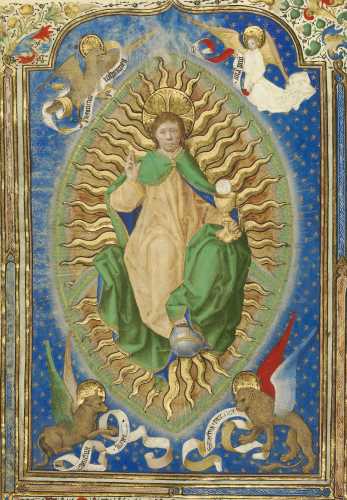 The Book of Revelation has numerous interpretations. The imagery is fantastic since John’s vision was in heaven, and we cannot begin to imagine the reality of heaven. When it was written, it revealed the past, present and future, and even today, it continues to do this. Many people focus on the prophecies of the end times, but there is so much more in this book than just those.
The Book of Revelation has numerous interpretations. The imagery is fantastic since John’s vision was in heaven, and we cannot begin to imagine the reality of heaven. When it was written, it revealed the past, present and future, and even today, it continues to do this. Many people focus on the prophecies of the end times, but there is so much more in this book than just those.
Revelation is a story of the Mass. This is clearly not the only truth conveyed in the book, but the eternal sacred Liturgy is at its core. We see this in a number of ways, and will look at what Revelation reveals about the Eucharist. The first half deals with the opening of the scroll (Liturgy of the Word) and the second half shows the pouring out of the bowls (Liturgy of the Eucharist). The book has liturgical images throughout, and it reveals the eternal Mass in heaven. Revelation also provides specific insight into the Eucharist and how the Blessed Sacrament is an eternal gift of Jesus.
- Revelation 1:10-13,20 – The Lord’s Day
- Revelation 2:17 – Hidden Manna
- Revelation 7:9-15 – Washed in the Blood of the Lamb
- Revelation 19:5-9 – Wedding Feast of the Lamb
- Revelation 21:1-3 – New Jerusalem
Revelation 1:10-13,20
I was caught up in spirit on the Lord’s day and heard behind me a voice as loud as a trumpet, which said, “Write on a scroll what you see and send it to the seven churches.” Then I turned to see whose voice it was that spoke to me, and when I turned, I saw seven gold lampstands and in the midst of the lampstands one like a son of man, wearing an ankle-length robe, with a gold sash around his chest. This is the secret meaning of the seven stars you saw in my right hand, and of the seven gold lampstands: the seven stars are the angels of the seven churches, and the seven lampstands are the seven churches.
St. John, as an Apostle, was a Bishop. He would have celebrated the Mass often and especially on Sundays, the Lord’s Day. Revelation opens on a Sunday, the Lord’s day, a day when John should be celebrating the Mass and receiving the Eucharist. John has been exiled to the Roman penal colony of Patmos. He is unable to worship as he should.
The book of Revelation is certainly a revelation from God for us, but it is also a personal gift to John. He cannot celebrate Mass with other Christians, and as a consolation, he is brought into heaven to be a part of the heavenly liturgy.
In scripture and particularly in Revelation, numbers have meaning. Seven represents completeness or totality. So, John is asked to send what he writes to the seven churches. This is an instruction to write to the entire church. His vision is for us as much anyone else.
John sees seven lampstands. This is an image of the menorah from the Temple. The menorah, with seven lamps, was specified by God in Exodus (Ex 25:31-40) and was required to be in the Tabernacle. Seeing seven lamps, John is seeing the Tabernacle in heaven.
The seven lampstands are not just an image from Exodus of the Tabernacle. John is told that they are the seven churches. The entire Church is in heaven. This occurs at every Mass. We are brought into heaven during the sacred liturgy.
John sees Jesus resurrected in heaven. He is wearing the clothes of a priest during the liturgy. His ankle-length robe and sash are the vestments of the eternal liturgy in heaven.
It is important to remember that what we see during the Mass is not the full reality of what is taking place all around us. Our high priest, Jesus, is present and offers the sacrifice on our behalf. We are surrounded by the entire Church (militant, suffering and triumphant), along with all the angels. We are truly in heaven during the Sacred Liturgy.
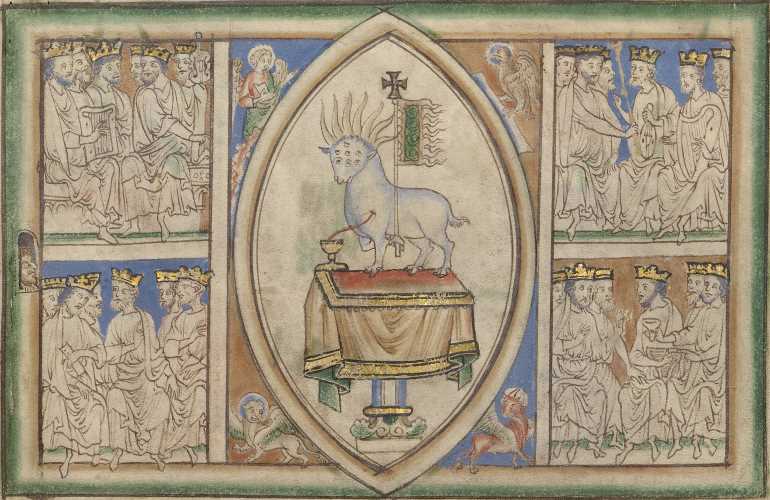
Revelation 2:17
Whoever has ears ought to hear what the Spirit says to the churches. To the victor I shall give some of the hidden manna.
 This verse comes at the end of Jesus’ letter to the angel of the church in Pergamum. It is a warning to all the churches at John’s time, but also for us today. We are called to listen to the Word of God, and we are promised hidden manna if we are victorious.
This verse comes at the end of Jesus’ letter to the angel of the church in Pergamum. It is a warning to all the churches at John’s time, but also for us today. We are called to listen to the Word of God, and we are promised hidden manna if we are victorious.
Our victory is getting to heaven. We are in a battle for our souls. God wants everyone to be in heaven with Him, but we have free will. We can choose to be separated from God for eternity, and God will respect this decision. Separation from God would be an utter failure, and only joining God for eternity in heaven is victory.
In heaven, we will receive hidden manna. In other words, we will receive the bread of life that we cannot see now. The bread of life is hidden under the appearance of ordinary bread and wine. We see, taste and smell ordinary bread and wine, but we are really receiving the body and blood of Christ.
The Eucharist is a great gift for us now. This gift is so great, in heaven, our reward is the Eucharist. Jesus gives us everything that He is when we receive the Eucharist, so it is impossible to ever receive more than what has already been given. Unfortunately, we recognize and appreciate the Eucharist as we should.
Revelation 7:9-15
After this I had a vision of a great multitude, which no one could count, from every nation, race, people, and tongue. They stood before the throne and before the Lamb, wearing white robes and holding palm branches in their hands. They cried out in a loud voice: “Salvation comes from our God, who is seated on the throne, and from the Lamb.” All the angels stood around the throne and around the elders and the four living creatures. They prostrated themselves before the throne, worshiped God, and exclaimed: “Amen. Blessing and glory, wisdom and thanksgiving, honor, power, and might be to our God forever and ever. Amen.” Then one of the elders spoke up and said to me, “Who are these wearing white robes, and where did they come from?” I said to him, “My lord, you are the one who knows.” He said to me, “These are the ones who have survived the time of great distress; they have washed their robes and made them white in the blood of the Lamb. For this reason they stand before God’s throne and worship him day and night in his temple.”
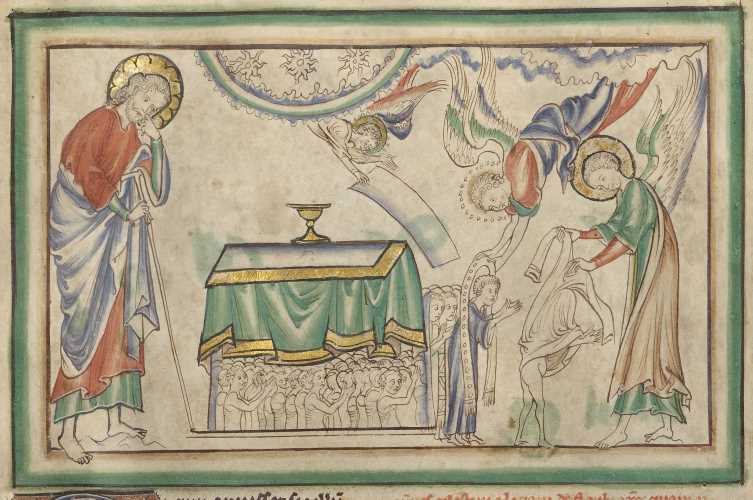 It is very encouraging to hear about the great multitude. We all know that we are completely unworthy of God’s love and mercy. Fortunately, God is infinitely loving and merciful and desires us in heaven anyway. The multitude in heaven is so great, no one can count everyone. We must never doubt God’s mercy. Always have hope and trust in God.
It is very encouraging to hear about the great multitude. We all know that we are completely unworthy of God’s love and mercy. Fortunately, God is infinitely loving and merciful and desires us in heaven anyway. The multitude in heaven is so great, no one can count everyone. We must never doubt God’s mercy. Always have hope and trust in God.
Jesus is the lion of Judah. He is the King of Kings and the Lord of Lords. He is the Alpha and the Omega. And yet, on the throne in heaven, He is the Lamb. Our Lord loves us so much that He humbles Himself as a lamb for eternity.
In Mass, it is easy to be distracted with all our concerns. What do I need to do at home? What is due at work this week? What bills do I need to pay? Why won’t the person in the next pew sing on key? Why is that person wearing that?
Many of us struggle to focus on what is really happening. The angels are good guides. Compared to us, even the lowest angel is more powerful than we can imagine. The angels, during the Mass in heaven as described by John, are prostrate and before the Lamb worshiping and praising Him. When we are distracted, we should remember this, and that our posture, at least interiorly, should be equally humble.
The multitude have been purified and perfected. Jesus commands us to “be perfect just as your heavenly Father is perfect” (Mt 5:48). This is tough. How can I be perfect like the Father? Well, the truth is none of us have a chance on our own. We need help, but God gives that help. The multitude have been purified and perfected, and we can too.
Jacob prophesied that Judah’s line would wash in the blood the grapes. We see the fulfillment of this here. The multitude washed in the blood of Christ. The Lamb of God gives us His blood in the Eucharist under the appearance of wine, and through this gift we are cleansed.
The Eucharist cleanses us and perfects us. God’s mercy and love are beyond comprehension. Our response needs to be like the multitude. We need to worship God day and night.
The multitude in heaven survived the time of great distress. God does not promise that life on earth will be without suffering, pain or hardship. We will experience distress. Jesus wants us to be with Him in heaven, and our material well-being on earth is only a means for that goal. We are not promised prosperity and comfort in this life. Instead, we are promised hardship and distress, but our reward is the eternal joy of heaven.
Revelation 19:5-9
A voice coming from the throne said: “Praise our God, all you his servants, (and) you who revere him, small and great.” Then I heard something like the sound of a great multitude or the sound of rushing water or mighty peals of thunder, as they said: “Alleluia! The Lord has established his reign, (our) God, the almighty. Let us rejoice and be glad and give him glory. For the wedding day of the Lamb has come, his bride has made herself ready. She was allowed to wear a bright, clean linen garment.” (The linen represents the righteous deeds of the holy ones.) Then the angel said to me, “Write this: Blessed are those who have been called to the wedding feast of the Lamb.” And he said to me, “These words are true; they come from God.”
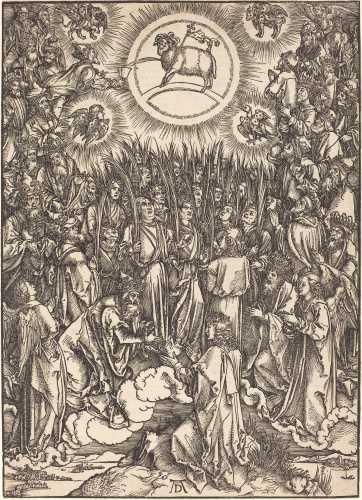
As Revelation approaches its end, we see the end we were made for. We were created to be in total communion with God. This union is a wedding, where we unite with the Lamb of God, the bridegroom. This brings us back to the very beginning. Adam, upon seeing Eve for the first time, said, “‘This one, at last, is bone of my bones and flesh of my flesh; This one shall be called ‘woman,’ for out of ‘her man’ this one has been taken.’ That is why a man leaves his father and mother and clings to his wife, and the two of them become one body. The man and his wife were both naked, yet they felt no shame.”
Through the Eucharist, we unite with Jesus in a much more intimate way. We become flesh of His flesh and blood of His blood. We are truly one body in Christ.
The implications of this are tremendous. Every time we receive the Eucharist, we are consummating a marriage covenant with God. We are saying through our reception that we want to be united with God. We are saying we are committed to this union. We are stating our faith in the Eucharist, and promising fidelity to everything Jesus has commanded.
Revelation 21:1-3
Then I saw a new heaven and a new earth. The former heaven and the former earth had passed away, and the sea was no more. I also saw the holy city, a new Jerusalem, coming down out of heaven from God, prepared as a bride adorned for her husband. I heard a loud voice from the throne saying, “Behold, God’s dwelling is with the human race. He will dwell with them and they will be his people and God himself will always be with them (as their God).
Heaven has become the New Jerusalem. In the Old Testament, Jerusalem was where the people went to worship and where they went to be with God. In the new and everlasting covenant, the New Jerusalem is heaven.
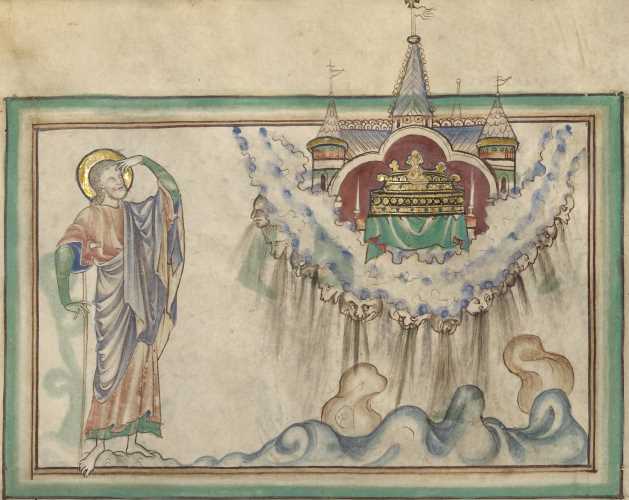 Shortly after this passage (verse 22), we read, “I saw no temple in the city, for its temple is the Lord God almighty and the Lamb.” No longer is the temple a separate location in Jerusalem where God can be found. Now, the temple is the Lamb.
Shortly after this passage (verse 22), we read, “I saw no temple in the city, for its temple is the Lord God almighty and the Lamb.” No longer is the temple a separate location in Jerusalem where God can be found. Now, the temple is the Lamb.
The New Jerusalem, with the Lamb of God, descends to earth. We truly can experience heaven on earth. This is not something imaginative, or some euphemism for being joyful. It is truly our reality. We can enter into heaven, the New Jerusalem, on earth today.
The image of the New Jerusalem coming down is compared to a bride adorned for her husband. This is an amazing image. God’s love for us calls us into an eternal intimate union with Him. The Eucharist is the consummation of this union when we become one flesh, one body in Christ.
Through the Eucharist, we have received the body, blood, soul and divinity of Christ. We are one body in Him. In this wedding with the Lamb, our weak and sinful body has been replaced with the perfect and infinitely loving body of Christ. We do not become gods, but we do unite and become one with Jesus. It is a tremendous mystery. How can we become one with God and yet remain distinct? We are clearly not worthy of the gift of the Eucharist or worthy of this wedding, but with the body and blood of Jesus, we are clothed with the merits and dignity of Jesus.
After the New Jerusalem descends, God promised that He will always be with His people. Jesus ascended into heaven, but He could not bear being separated from us. This is why the New Jerusalem descends, and why Jesus remains with us always. This is already fulfilled, and Jesus is with us in every Mass and in every Tabernacle. He has not left us and will never leave us.
The Mass is the union of heaven and earth. It is where the New Jerusalem descends and when we encounter the Holy City. The Lamb of God is present, physically and spiritually, at every Mass. We are truly in heaven, surrounded by a multitude of angels and saints, and before us is the Lamb of God.
Images:
Antoine de Lonhy (French, active about 1460 – about 1490), Christ in Majesty, about 1460, Tempera colors, gold leaf, and gold paint on parchment, Leaf: 34.5 x 25 cm (13 9/16 x 9 13/16 in.), Gift of the Emerson Family in honor of John S. Bonnell
Unknown, The Vision of the Lamb in the Midst of the Four Living Creatures and the Twenty-Four Elders, about 1255 – 1260, Tempera colors, gold leaf, colored washes, pen and ink on parchment, Leaf: 31.9 x 22.5 cm (12 9/16 x 8 7/8 in.), The J. Paul Getty Museum, Los Angeles
German 15th Century, Monstrance Held by Two Angels, Dated 1495/1500, Rosenwald Collection, National Gallery of Art
Unknown, The Opening of the Fifth Seal: The Souls of the Dead Receiving White Robes, about 1255 – 1260, Tempera colors, gold leaf, colored washes, pen and ink on parchment, Leaf: 31.9 x 22.5 cm (12 9/16 x 8 7/8 in.), The J. Paul Getty Museum, Los Angeles
Dürer, Albrecht, German, 1471 – 1528, The Adoration of the Lamb, probably c. 1496/1498, National Gallery of Art
Unknown, The Temple of God with the Tabernacle in the Sky, about 1255 – 1260, Tempera colors, gold leaf, colored washes, pen and ink on parchment, Leaf: 31.9 x 22.5 cm (12 9/16 x 8 7/8 in.), The J. Paul Getty Museum, Los Angeles